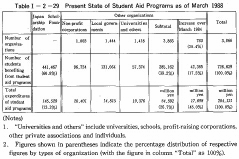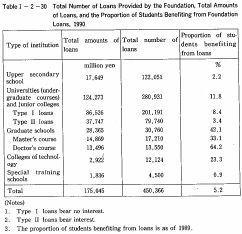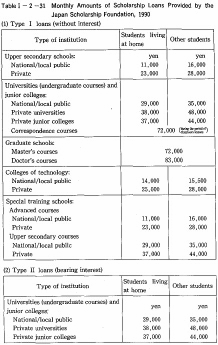| Home > Policy > White Paper, Notice, Announcement > White Paper > JAPAMESE GOVERNMENT POLICIES IN EDUCATION,SCIENCE AND CULTURE 1990 > PART |
||
In order to assist students with their character formation, universities give them not only instruction in classrooms, but also assistance, advice and guidance with regard to their activities other than classroom work. These assistance, advice and guidance were introduced after the end of World War II with "student personnel services" in American colleges as a model. These services comprise two categories of service: "welfare services providing students with material and indirect assistance" and "guidance services providing them with personal and direct guidance."
The importance of these student personnel services was pointed
out in the report of the Student Welfare Council published in 1958 and in the
report of the Central Council for Education published in 1963. The quantitative
expansion of higher education in recent years has led to a great increase in
student enrollment sand the diversification of students in terms of their abilities,
aptitudes and interests. In the context of this change, in the characteristics
of university students, student personnel services at universities have been
more and more diversified, and the role which these services have to play has
been greater. There has been a growing call for enriching and expanding these
services.
In universities, all students are expected to draw on their own autonomy and spontaneity with regard to learning and all other aspects of student life. As many students are compelled to live separately from their parents, and as the life style of university students is drastically different from that of elementary and secondary school students, there are many students who are worried about their own mat-adjustment to the university environment. Students' worries have become more diverse, along with the quantitative expansion of higher education and the diversification of students' value systems.
Student counseling services are intended to help students solve these worries so as to enable students to adapt themselves to university life and thus to help them make their learning more effective. Individual universities provide student counseling services at a student counseling room, a counseling center or a health management center.
Student counseling services deal with not only students' mental diseases but also other diverse troubles including students' worries about academic learning, students' maladjustment, including apathy, to university life, and students' troubles regarding personal relations with their friends.
Student counseling services play a key role in the whole guidance
work in student personnel services. Not merely experts in student counseling
but also all teachers are expected to contact students with a counseling-oriented
mind (or a mind ready for listening to students' worries and for giving them
kind and sincere advice).
Entering employment is a very important event for students as a starting point of their social life. It is also of great significance for universities, as it means a return of the outcomes of their educational programs to society.
In accordance with the Employment Security Law, individual universities provide graduating students with employment placement services. This is not only because universities are established organizations which have a great many students wishing to enter employment, but also because, in placing university graduates into appropriate workplaces, consideration should be given to the specific expertise of each graduate.
In addition to employment placement services, various guidance services are provided for students with regard to employment. Employment guidance includes guidance intended to help students develop a proper understanding of employment, tests designed to help students ascertain their own aptitudes, counseling regarding employment and the provision of relevant materials for students.
With regard to the employment of university graduates, in its first report published in June 1985, the National Council on Educational Reform recommended that "industrial firms should abolish its practice of early recruitment of university graduates which violates the recruitment agreement by employers' associations and which tends to give preference to students from prestigious universities," with a view to correcting the adverse effects of undue emphasis on the educational back-ground of individuals. In this respect, it is strongly urged that industrial firms comply with the recruitment agreement concluded by all universities and major industrial enterprises, because this agreement has been playing an important role in enabling fourth year students to be successfully engaged in their education in good order and to gain a fair opportunity to choose an occupation, in the context of a "sellers' market" of employment supported by a business boom.
Along with changing social and economic situations in recent
years, it has been pointed out that most graduates from science fields tend to
choose and enter industries other than manufacturing and that an increasing number
of new employees transfer to another workplace soon after their employment in
a particular workplace because they find the first workplace inappropriate for
them. In order to cope with such unprecedented tendencies, universities are expected
to provide students with such careful employment guidance as is adapted to the
circumstances of each university and as will meet the diverse demands of diverse
students.
If students are to live a fulfilling university life with regard both to their study and to extra-curricular and other non-academic activities, the provision of a proper environment is quite important for students. To this end, individual universities are striving to develop and improve student welfare facilities, which are key facilities contributing to a better campus environment for students. Major facilities for student welfare are as follows:
The "university center" of each university is a core facility
for students' campus life outside the classroom. In each center there are halls,
meeting rooms and lounges for seminars, workshops and other meetings, restaurants,
tearooms, stores, etc. Each center organizes various events and programs, playing
an important role in the campus life of students and teachers and in personal
contacts among students and teachers. Eighty-two national universities have such
a center, and some more are planning to set up a center of this kind.
Another facility designed to help students live an enriched campus life is a student dormitory. According to the "Survey of Student Living" conducted in1988, about 6% of all university students were living in student dormitories in the same year.
Recent dormitories in national universities provide primarily single rooms so as to meet the demands of contemporary students. Double rooms and quadruple rooms have been decreasing. The number of students living in a single room at student dormitories increased from 8,002 in 1980 to 14,495 in 1988. (The number of students sharing a room with other students decreased from 21,091 in 1980 to 16,862 in 1988.) Along with an increase in the number of foreign students, a growing number of universities have allowed foreign students to live in existing student dormitories, and in recent years many universities have constructed a student dormitory presuming that foreign students are allowed to use it in addition to Japanese students.
c Facilities for extra-curricu1ar activities
Apart from university centers, many universities have separate
facilities for students' club and circle activities. Many national universities
have developed common facilities which have training rooms, meeting rooms and
other space to be jointly used by different clubs and circles. Many universities
also have separate facilities for residential training for club activities. Apart
from these residential training facilities at individual universities, there
are 13 common facilities for residential training to be jointly used by national
universities in respective regions. These facilities are used not only for club
and circle activities but also for seminars and academic activities. In addition,
there are two "university seminar houses," one in Tokyo and the other in Kobe,
which are operated by non-profit corporations for the use of students enrolled
in any national, local public and private universities. These houses have been
contributing to the exchange of views and information among public and private
university students, by organizing their own programs and by other means.
Student aid programs are very important programs whereby loans and grants are provided to those students (including secondary school students) who find some difficulty in continuing their study for financial reasons. These programs have been contributing both to the development of competent human resources and to the provision of equal opportunity in education. The government has been striving to improve and expand these programs.
According to a nation-wide survey of student aid programs conducted
by the Ministry of Education. Science and Culture every four years, the latest
figures (as of March 1988) about these programs are as follows: (See Table ![]() -2-29.)
-2-29.)

a. The number of organizations carrying out student aid programs 3,866
b. The number of students benefiting from these programs 727,000
Of this total, 442,000 (61%) were assisted by the Japan Scholarship Foundation, and the other 285,000 (39%) by other non-profit corporations, local governments, universities and others.
c. The total amount of loans and grants provided 204,100 million yen
Of this total, 149,500 million yen (73%) was provided by the Japan Scholarship Foundation, and 54,600 million yen (27%) by other non-profit corporations, local governments, universities and others.
In the light of the recommendation made by the National Council on Educational Reform in its third report published in April 1987, the Ministry has been making efforts to heir improve and expand the student aid programs of the Japan Scholarship Foundation, and also to help develop and expand diverse student aid programs carried out by non-profit corporations, local governments and other bodies.
2) Student aid programs by the Japan Scholarship Foundation
The Japan Scholarship Foundation provides loan scholarships for able students (including secondary school students) who find difficulty in continuing their learning for economic reasons. The Foundation was inaugurated in 1943. The total number of students benefiting from the scholarships by the Foundation was approximately 4,350,000 during the 47 years from 1943 to 1990 and the total sum of the loans provided by the Foundation during the same period amounted to 1,815,000 million yen. The loans of the Foundation are financed by funds from the national government and repayments by former borrowers.
In order to expand the Foundation's programs while making them adapted to changing social and economic circumstances, in 1984 the Foundation introduced some innovations in their programs for loans without interest. In addition, in the same year the Foundation created a new program for loans bearing interest, with the help of the government's special funds for the Financial Investment and Loan Program. The introduction of this new program was intended to contribute to the quantitative expansion of the Foundation's loans, while coping with the popularization of higher education in the country. The new loans bearing interest are offered to students enrolled in universities and junior colleges. With a view to alleviating borrowers' financial burdens to a minimum, borrowers have only to repay their loans with very low interest in installments for a long time. (Borrowers will begin to repay their loans after graduation from a university or junior college. The interest of a loan is 3% per year. The loan bears no interest while the borrower is enrolled in a university or junior college.) The balance between the interest of scholarship loans provided to students and the interest of the long-term loans of the government to the Foundation is borne by the government.
In the light of the recommendation offered by the National Council
on Educational Reform, the Foundation further increased the number of new loans
by 2,800 in 1990 (1,200 for master's degree students, 1,000 for doctoral students
and 600 undergraduate students). As a result, the total expenditures of the loan
programs of the Foundation amounted to 175,000 million yen in fiscal 1990 (an
increase of 9,400 million yen over the previous fiscal year), and the total number
of scholarship loans reached 450,000 in 1990. (See Table ![]() -2-30.)
-2-30.)

The proportion of university students benefiting from the scholarships by the Foundation was 12% for undergraduate students and 42% for graduate students (33% for master's degree students and 64% for doctoral students.)
Taking account of trends in tuition fees and other student expenditures and in students' family income and expenditures, the Foundation has been striving to improve and expand its student aid programs to adapt them to the economic conditions of students who need financial assistance.
3) Student aid programs by non-profit corporations, local governments, universities and other bodiesAccording to the Ministry's survey of student aid programs, in March 1988, 3,865 non-profit corporations, local governments, universities and other bodies were carrying out some student aid programs. Approximately 285,000 students were benefiting from these programs, and the total sum of loans and grants provided under these programs amounted to 54,600 million yen.
The total number of students benefiting from these programs as of March 1988 represented an increase of 42,000 (or, an increase of 18%) during the previous four years, and the total amounts of loans and grants represented an increase of 17,700 million yen (or, an increase of 48%) during the same period. The total number of students benefiting from these programs represents 40% of total students benefiting from loans and grants provided by all organizations including the Japan Scholarship Foundation, and the total sum of loans and grants under these programs accounts for nearly 30% of the total sum of loans and grants provided by all organizations including the Foundation.

The diverse student aid programs undertaken by non-profit corporations and other bodies are of great value for the development of student aid programs in Japan. As compared with the Japan Scholarship Foundation undertaking general and comprehensive student aid programs, many of the other organs provide unique and distinctive student aid programs of great significance, on the basis of the specific aims of the programs. These programs include those primarily for students who have lost their parents for particular reasons, for foreign students and for graduate students. These programs are expected to make further contributions to the development of competent human resources, as well as to the equal access of students to education.
With the aim of promoting student aid programs, non-profit corporation carrying out these programs are entitled to exemption from taxation for a part of their income (interest of loans, donations, etc.) for these programs. Donations by individuals and private enterprises to non-profit corporations carrying out student aid programs are also exempt from taxation under certain conditions. (Tax-free donations are those to certain non-profit corporations designated by the government as certain "public benefit promotion corporations" and those of certain categories as designated by the Minister of Finance as tax-free donations.)
In order to secure more funds for student aid programs from private enterprises and charitable persons, the government needs to make more efforts to strengthen its public relations activities so that as many people as possible may understand the significance and role of student aid programs.
| Back to Top | MEXT HOME |